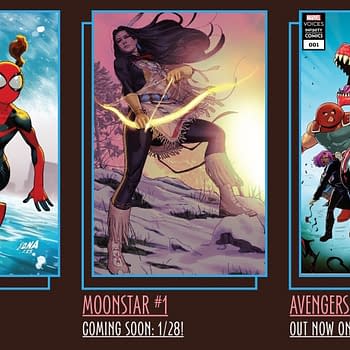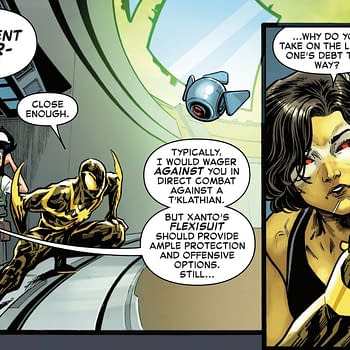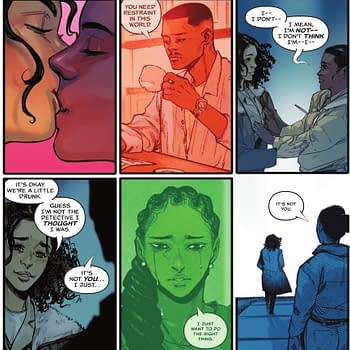Posted in: Comics | Tagged: Adventure Time: Marceline Gone Adrift #6, Batman #41, battleworld, Bloke's Terrible Tomb of Terror, Bloke's Terrible Tomb Of Terror #9-11, Comics, entertainment, idw, Long Distance, Marvel Comics
Thor's Comic Review Column – Battleworld Titles, Bloke's Terrible Tomb Of Terror #9-11, Long Distance, Adventure Time: Marceline Gone Adrift #6, Batman #41
This Week's Reviews:
Battleworld: Marvel Zombies #1
Battleworld: Mrs. Deadpool and the Howling Commandos #1
Battleworld: 1602–Witch Hunter Angela #1
Battleworld: Ghost Racers #1
Battleworld: Weirdworld #1
Battleworld: Ultimate End #2
Bloke's Terrible Tomb of Terror #9, #10, #11
Long Distance
Adventure Time: Marceline Gone Adrift #6
Batman #41
Battleworld: Captain Marvel and the Carol Corps #1
Jeb Returns to Battleworld
This week's Battleworld titles bring us a batch of comics centered on women protagonists. My compadre Adam X will be covering the first issue of Captain Marvel and the Carol Corps below, but that still leaves me with plenty of female-focused titles to review.
Battleworld: Marvel Zombies #1 (Marvel, $3.99)
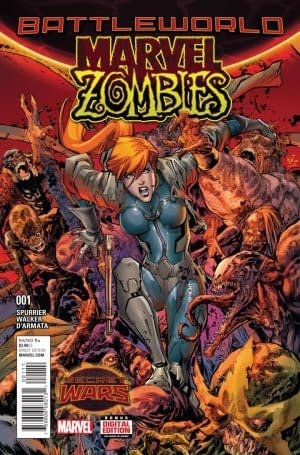
Marvel Zombies is another Battleworld title exploring the cracks that are beginning to appear in the surface of Doom's world, as Elsa concludes the first issue by setting off onto a quest into the unknown, and readers might either find it intriguing or frustrating that, at this point, we actually don't know much about what might lie ahead for her; we've basically had 20 (admittedly entertaining) pages of introduction. Artist Kevin Walker and colorist Frank D'Armata are working in a darker palette than Immonen's Nextwave, but they evoke its over-the-top action as Elsa dispatches some monstrously ghoulish variations on familiar Marvel baddies. My principal reservation about this first issue is that, with only three left to go, we have spent a lot of time with Elsa's backstory (including flashbacks that don't really tell us much more than her internal monolog, or the conversations with her new confidant, do), leaving some heavy lifting still to be done to set up the actual storyline; hopefully Spurrier and Walker won't have to rush through it.
Battleworld: Mrs. Deadpool and the Howling Commandos #1 (Marvel, $3.99)
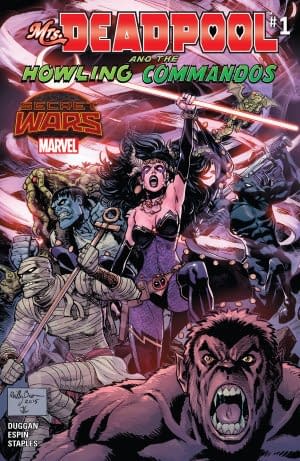
In giving us this set of "Howling Commandos" for Shikla to team up with, there's a sense that Duggan is tweaking Universal's announced plan to create a linked cinematic universe, like Marvel's, out of their stable of classic movie monsters, most of whom appear here (with Man-Thing more or less standing in for the Creature From the Black Lagoon). His approach is decidedly lower-key than the sort of Mad Magazine parody that might suggest: mostly, Jack Russell, the Mummy, Frankenstein's monster and the rest, stand around smirking and tossing off dry quips; presumably the real action starts next issue. Most of the jokes come in Deadpool's ghostly narration-from-beyond; more outright humor in the book would actually be welcome, but Duggan does resist the temptation to let Wade take over the proceedings. Artist Salva Espin and colorist Val Staples blend the macabre and the madcap in the visuals, making this one of the best-looking Scooby Doo homages ever.
Battleworld: 1602–Witch Hunter Angela #1 (Marvel, $3.99)

Between Bennett's prequel section, and the main story from herself and Gillen, this first issue is actually pretty dense with event and characterization, and strikes an ideal balance between being a satisfying single-issue installment while setting up the story to come.
There's an arch quality to much of the humor (the credits page, and some of the dialog, read like something out of Blackadder), and while the book does have a strong emotional throughline in Angela's relationship with Serah, the entertaining script is sometimes warring between pseudo-Shakespearean wryness and wised-up 21st century snark (the sound effect for a halberd cutting its prey in two is "Slyce"). I won't spoil the various Marvel characters who have been 1602-ified here, but the preview page for the next issue looks like the most delightfully demented repurposing of a super-team ever.
If the decision to employ two strikingly-different artists on this book allowed more time to be taken in its completion, then it was probably a good thing, but there's no question that there's a rather jarring contrast between Marguerite Sauvage's cartoony, manga-flavored prelude (which actually runs about a third of the book) and Stephanie Hans' darker, more period-inspired work. Each is gorgeous in its own way, with strong characterization and lots of impact to the action scenes; it would also appear that both artists did their own excellent coloring.
Unlike Elsa Bloodstone and Shikla, Angela didn't need a Battleworld book to get her chance to shine, but Bennett, Gillen, Sauvage and Hans take nothing for granted, going all-out to make this one of the most impressive comics of the event so far.
Battleworld: Ghost Racers #1 (Marvel, $3.99)
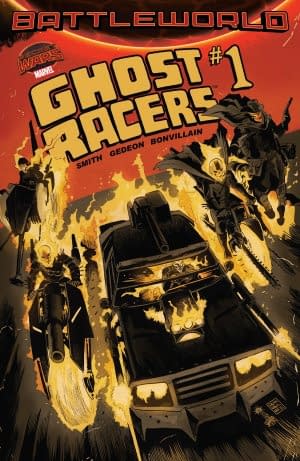
Battleworld: Weirdworld #1 (Marvel, $3.99)
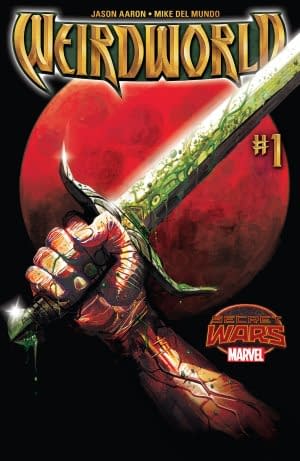
Arkon, a Conan/Krull type who I vaguely recall turning up in some Avengers books over the years, is battling his way through a monster-choked region of Doom's world, half-crazed with trying to remember his past or purpose. He babbles to himself, and to us, he consults a crude map he's drawn that probably holds all manner of Battleworld secrets for those canny enough to decipher it, he hacks and slashes and smashes and nearly drowns, and while Aaron's script is tight enough to keep this from feeling redundant, it's Del Mundo's art that makes this comic an absolute must. I think this is the first sequential work I've seen from the prolific cover artist, and it's an eye-popping homage to sword and sorcery predecessors like Alan Davis and John Buscema, with visual stylings that recall the over-the-top excess of underground artists like Moebius or Vaughn Bode, and the garish sci-fi paperback book covers of the 70's. And while Del Mundo does give us some pretty definitive ogres and dragons here, it's the squidshark you won't forget anytime soon. Phenomenally recommended.
Battleworld: Ultimate End #2 (Marvel, $3.99)
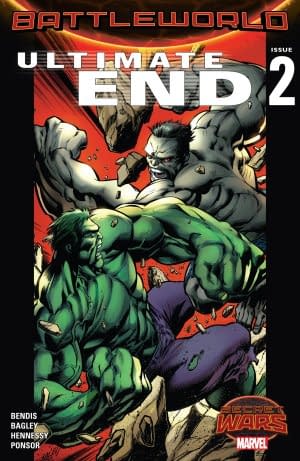
Jeb D. divides his day between working with lawyers and working with actors. No wonder the guy's going grey.
Bloke's Terrible Tomb of Terror #9, #10, #11 (Jason Crawley, $2.99)
By Cat Taylor

The convention of horror comic anthology books was made famous, or infamous at the time, by the old EC Comics that were eventually banned by the Comics Code Authority. These comics collected several short horror stories that were only connected by a common host like the Crypt Keeper or Old Witch as a framing device. With the exceptions of these hosts, nobody really cared about the actual characters in the stories because they would never be seen again. The stories were all about scary surprise endings. They were like old campfire ghost stories but with creepy artwork to accompany them.
With Bloke's Terrible Tomb of Terror, the publisher and head writer, Jason Crawley, not only captures the nostalgia for those old EC Comics in spirit, but he practically clones those books. You can see most of the "twists" coming from the first page of each story and I know I've read other versions of many of these stories before. I guess a lot of horror stories are like old blues songs. They're hard to copyright because they've been passed down orally for so long that nobody can track their exact origins.
Although many different writers are used in each issue, including original Warren Publishing writer, Roger McKenzie, the story styles are so similar that no particular author stands out. For his own part, Crawley has created a framing horror host called the Bloke, a Victorian undertaker, to be the obligatory guide through the stories. In addition, Crawley plays the character of The Bloke himself at various horror and comic conventions.
What little originality there is in these comics is in the art. For the most part, like the writing, the artwork of the many different illustrators harkens back to the style of Bernie Wrightson and artists from the old EC Comics. Also the covers produced by artist and co-writer, Mike Hoffman, look like long, lost paintings from Frank Frazetta. However, occasionally, these comics use artists like Rock Baker and Scott Shriver who turn out results that look more like something from Dan Clowes or the Hernandez Brothers as opposed to the type of renderings that are more common with horror comics. It's an interesting break in an otherwise extremely uniform tone.
When it comes to horror anthologies, it seems that originality is rarely a concern. People who like these sorts of stories seem to dig the familiar. The nostalgia of the old stories that frightened people as children and the predictable anthology approach seem to trump any desire for new and innovative scares, which is ironic for a genre that relies on shock and suspense. Be that as it may, comics like this as well as movies/TV shows like Tales from the Crypt continue to be popular among horror fans. So, if you know what this is, then you probably know if you'll like it or not.
Cat Taylor has been reading comics since the 1970s. Some of his favorite writers are Alan Moore, Neil Gaiman, Peter Bagge, and Kurt Busiek. Prior to writing about comics, Taylor performed in punk rock bands and on the outlaw professional wrestling circuit. During that time he also wrote for music and pro wrestling fanzines. He doesn't have a PhD, but you can call him Dr. Love. You can e-mail Cat at cizattaylor@hotmail.com.
Long Distance (IDW Publishing)
By Bart Bishop
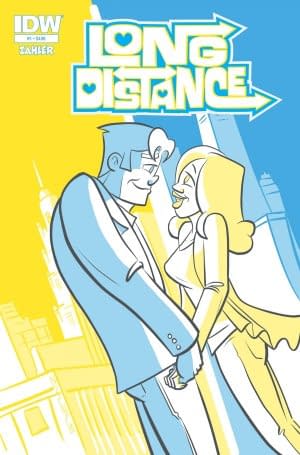
The opening issue is firmly from the perspective of Carter Blue, the male lead. He's flashing back by telling his story of a long-distance relationship to a woman he has just met in the airport. He's an artist who owns his own ad agency with his college friend Tim, and Lee Smith is a rocket scientist doing work for NASA. He lives in Columbus, Ohio and she's in Chicago, and their meet-cute takes place during a wintery flight delay. They have a magical time, bonding over the differences between Star Trek and Star Wars, and then return to their respective homes only to hit things off on Twitter and via texting. Whether or not it's the right choice, Carter decides to book a flight to Chicago to see Lee for the following weekend, jumping headlong into the kind of romance that Hollywood fetishizes. Tim is a little hesitant for Carter, and Lee's friend Marissa is a little hesitant for her, but in the end both are encouraged to pursue this flight of fancy. Things end on a hopeful note, but there's the fact that Carter says he "used to be in a long-distance relationship" at the beginning that perhaps denotes a sense of ambiguity.
Zahler has a handle on the spontaneity of love at first sight, but more importantly how a relationship develops from there. The chemistry between Carter and Lee is evident, as they banter back and forth with the kind of Sorkin-esque hyper-clever dialogue that's only spouted in fiction. Wouldn't it be nice to always know the right thing to say? Unfortunately, and this is showing my bias here, but most of this dialogue centers on them bonding over geeky interests. Just throwing this out there, but I absolutely hate The Big Bang Theory for how it exploits nerd culture. I'll give Zahler this, their inside baseball jargon feels like it comes from a genuine place, but it also makes the characters appear to one up each other, which drives me crazy. What does work for me, as I mentioned above, is that they have functioning lives out in the real world. No failure to launch here, this is two people with successful jobs working hard and getting by in the world. It's amazing how often manufactured drama is used to add nuance, but here it's all character-based.
As mentioned before, the artwork could have been restrained a bit. It's fine to go for cartoonish and impressionistic to convey a thematic concern, in this case the lightness of the tone and the perceptions of the characters, but the features go overboard. Carter, for instance, looks like a linebacker and his hair appears to be made of plastic, whereas Lee's lips look like they may envelop her face. That's not to say the artwork isn't aesthetically pleasing, it just feels like its attempt at precociousness is amped up beyond relatability. Still, something I absolutely love about the book is the use of the color filter to individuate the specific sequences, really conveying particular moods, like the lavender over the snowed-in airport, etc. I can't remember this outside of Shawn Martinbrough's work on Detective Comics years ago, so it really stood out here.
An accurate and honest look at when the heart overrides the mind, this is a book that takes a well-worn story and gives it a 21st century sheen.
Editor and teacher by day, comic book enthusiast by night, Bart has a background in journalism and is not afraid to use it. His first loves were movies and comic books, and although he grew up a Marvel Zombie he's been known to read another company or two. Married with a newborn, he sure hopes this whole writing thing makes him independently wealthy someday. Bart can be reached at bart.bishop@cincinnatistate.edu and on Twitter @BartLBishop.
Adventure Time: Marceline Gone Adrift #6
By Adam X. Smith
What time is it? It's review time – come on, grab your friends, we'll go to very distant lands.
Sorry, couldn't resist.
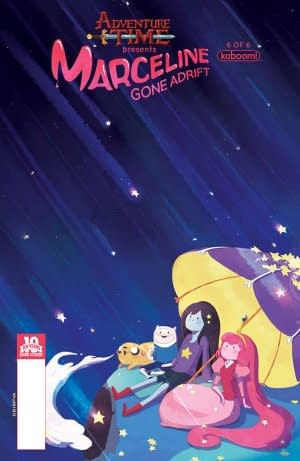
Yes, I'm as surprised to be writing these words as you probably are reading them, but before reading the series my understanding of their relationship was that they were simply the prim princess and the sparky hot-headed femme fatale vying for the affections of Finn, and given my limited knowledge of the show that may well have been accurate or not. However, what the comic series gives us is a view of their previous relationship as friends who drifted apart because of the roles they chose or were given, became sort of bitter towards one another, and now as a result of a bizarre event are put in a position where they are forced to reconcile to some degree.
And that's cool. Really, you can make a good story out of anything, but that central dynamic which plays out over the course of the series works so well you don't really need anything else to justify it. It's fortunate then that the book also has the continuing B-plot of Cinnamon Bun transforming into the Blob and Finn having a bizarre existential crisis that prevents him from doing anything to tide things over until their eventual return.
Look, I'm not gonna waste your time here: if you're the kind of person who enjoys Adventure Time but hasn't read the comics, check it out. If you're a big Adventure Time fan and read the comics anyway, chances are you already reading it or are thinking about it; in that event, definitely check it out. If you run kind of hot and cold on the show but know someone who's into it, maybe recommend it to them. I'm not the best objective judge of whether it's a good adaptation of the show or its style, but it's a fun all-ages comic by a publisher that is filling a gap in the market. And sometimes that's enough.
Adam X. Smith's original byline bemoaned the likelihood that his copy of Captain Marvel and the Carol Corps was probably not going to arrive in time. Sometimes the cosmos gives, sometimes it takes away.
Batman #41 (DC Comics, $3.99)
By Devon Sanders (@devonsanders)
This issue is just an entirely ridiculous thing and I am thankful for it.
I've been away from Batman proper for a bit. The book's tone had set a course and in my perception, had become overly grim and just wasn't what I was looking for in my Batman. I wrote a bit about it elsewhere.

First order of business? Take Bruce Wayne out of the picture. Next, put James Gordon, a 46-year old chain-smoking cop inside of a suit of armor more resembling a bunny than a bat. Acknowledge the ridiculousness. And then, drop said 46-year old, chain-smoking cop inside the suit of armor onto a three story tall electrical monster and hope that new readers and old don't wonder if you've lost your f@%#ing mind.
And that is a bit of the brilliance of this issue, I think. It's bold; I haven't read an issue of Batman in a bit and Snyder doesn't go into a ton of detail as to why something so crazy as Gordon as Batman is happening. No, it's simply what needs to happen; it's more that Gotham is without a Batman and the one with enough heart to fill the bill is a James Gordon. Snyder, like Gordon, after putting in the effort, is asking for a bit of faith in his ability to make this thing work.
For now, he's got it.
Batman #41 is an enjoyable, thoughtful thing full of surprise and shockingly, hope. The way everyone rallies around Gordon to make this thing work in order to make sure that Gotham has a Batman is pretty inspiring.
Pulling all of this together wonderfully is artist Greg Capullo; there's a lot going on in this issue and some of the best stuff on the page is Gordon's reactions to it all. In his hands, Gordon's raising of an eyebrow or the weird tilt of his mustache becomes storytelling. It enhances the written word; Capullo's Gordon is a man who needs as much convincing as anyone that this is a thing that could work. Capullo is, once again, on top of his game.
Batman #41 is a very welcome change of pace; it gives me feels I haven't felt in a while. It leaves me looking forward to a next issue.
Devon Sanders has mastered the Two-Inch Punch. Stay two and a quarter inches away and you may just survive the experience. He can be found on Twitter at @devonsanders.
Captain Marvel and the Carol Corps #1
By Adam X. Smith
Sometimes life is good.
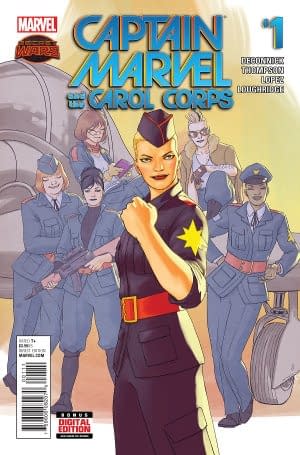
However, for anyone not quite ready to cast off DeConnick's vision of the character or David Lopez's artwork, this book is basically a strange mashup of their stylistic take on Danvers set in the environs of Hala Field, a region of Battleworld ruled by Baroness Cochran that is defended by Banshee Squadron aka "The Carol Corps", an elite all-female team of fighter pilots led my Captain Marvel herself. So, given that most of the books so far have been developed around a sort of "blank meets blank" or "like blank but…" formula, it's essentially Top Gun meets… well, Captain Marvel, I guess, complete with Kenny Loggins references.
If that surprises you, then good, because there's a subtle undercurrent of un-reality about the book's setting that immediately registers in the mind as sinister. Per the logic of Secret Wars' version of the world, this version of Carol's powers are attributed to being "a gift of Doom", and she finds herself struggling to reconcile the version of reality she has been forced to believe versus the logical and scientific observations of Corps member Bee. However, following a series of events – including an encounter with Kit Renner, formerly Carol's biggest fan and currently Hala Field's designated Thor – that raise doubts in her mind regarding her superiors' motives and orders and even the origin of her powers, she becomes determined to find out what's on the other side of the sky. Literally.
This is what I love about Carol, especially during Kelly Sue's run. She is, like Steve Rogers before her, not a perfect soldier, but a good person first and foremost, who strives to use her powers for the betterment of all and to push the boundaries of what humanity is capable of higher, further, faster and more. At a time when debate over a supposed "feminist agenda" in entertainment continues to amount to a little bit of nuanced discussion and a metric fuck-ton of bellicose ranting from all sides, it's really refreshing for a mainstream book to have an exclusively female cast (bar one male character whose job is to be unconscious and get rescued by Carol) and for it to make absolutely no difference to me as a reader or to the story.
Perhaps the fact that I'm the target audience helps, but the very fact that gender seems to play no role in the drama of the book, and the fact that each of the Corps members is distinct both visually and personality-wise, goes a long way to making it just a fun book without the supposed feminist subtext having to pull focus. It's definitely in there, as it always has been with Danvers ever since she started off as Ms. Marvel, butting heads with J. Jonah Jameson and being an independent super-woman forty years before we got to see Hayley Atwell's Agent Carter busting balls and taking names; but all that doesn't mean it can't be fun too.
That being said, this is clearly a book written for the fans, the people who made the Carol Corps a thing IRL. I'd be remiss not to mention co-writer Kelly Thompson's input: whilst I don't know much of her previous work and taking the book on face value it's hard to see where DeConnick ends and Thompson begins, that kind of collaboration always impresses me a lot more than a co-writing combination that feels too obvious on the page – DeConnick's run with Warren Ellis on Avengers Assemble suffered a little from it, with their two styles gelling in certain places but wildly clashing in others.
All in all, a great start to a run that I hope will serve as a capper to a great series. Whatever the plans are for Colonel Danvers' future – and Fearless Leader claims that there probably are a few big changes afoot – she continues to be an example of just how well a female superhero can be written, and I hope that doesn't change anytime soon.
Adam X. Smith doesn't put a lot of stock in the idea of Angelina Jolie directing a Captain Marvel movie, but if it gets Charlize Theron the job, he's not going to complain. He's also writing some more stuff for @ElectrolyteMag and working on a pilot. Standby.










